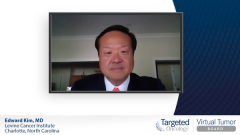
Case 1: Small Cell Lung Cancer in the Era of Immunotherapy
Episodes in this series

Mark Socinski, MD: At ASCO you showed KEYNOTE-604. The other presentation was an ECOG phase 2 trial grafting nivolumab on to the same platform of platinum-etoposide. I walked away from ASCO saying, “We really do have a new standard of care.” I know technically KEYNOTE-604 was a negative trial, but it was almost the same effect adding pembrolizumab. Obviously, it won’t gain FDA approval, nor does it have to gain FDA approval in this setting. We have 2 good choices here. In your mind, is durvalumab-atezolizumab like the Coke-Pepsi argument? Are they the same? Do you view them any differently? Which do you use in your practice or your pathway? Comment on that.
Edward Kim, MD: I agree with you first about the pembrolizumab data. It was close, and many of us thought it was going to be positive. And it’s surprising—that’s why you play the game, right? You finish strong. We’ve had both of these regimens on our small cell extensive-stage pathway. We consider them very similar: The profiles are very similar as well. I’ve leaned more toward durvalumab. If you’re splitting hairs, a little more response and a little more OS, but very similar. So, we allow both regimens on our pathways.
Mark Socinski, MD: It’s hard for me to ask this question, but you know the atezolizumab-durvalumab is a little more interesting than the carboplatin-versus-cisplatin argument. I think we have plenty of phase 3 data, at least in extensive-stage disease. Let’s say they’re equivalent in that setting. Your thoughts on that in the era of immunotherapy? Most of us have always felt that maybe cisplatin is a little more active, but it’s hard to prove it in this setting. Maybe with immunotherapy, do you have any sense of that or is it just Coke-Pepsi again for the cytotoxic?
Edward Kim, MD: I try to lean toward cisplatin when I can. In the extensive-stage standpoint, sometimes you see patients who are a little sicker. I don’t know if it works any better, especially in an incurable situation, and immunotherapy may be an equalizer for them. So yeah, I agree. It’s less relevant for me in the extensive-stage setting. If we get data down the road in the early stage setting or the local setting, then certainly we lean toward the cisplatin-based therapies.
Mark Socinski, MD: What’s your sense? I was going to ask you this early on when you were discussing the NCCN Guidelines, because they still list platinum- etoposide as a standard or an option. Small cell lung cancer is a population of patients who tend to have a high incidence of paraneoplastic syndromes. Many of these, particularly the neurological ones, may be immune related. I guess the question is, what are your thoughts there? How often do you see a patient where you don’t want to use immunotherapy for 1 reason or another in this population? Give us your thoughts about that.
Edward Kim, MD: It’s rare that I find a patient I can’t or don’t want to treat with immunotherapy. Early on we were very conservative in who we approached. If they had even a hint of history of rheumatoid arthritis or anything like that, we got a little skittish. We’ve seen that these are very well-tolerated drugs, so there must be a pretty high bar to really not give the effective therapy. Like COVID-19, we’re still learning. Everybody said, “Don’t use steroids in COVID-19.” It was interesting. Melanoma doctors were really advocating for it early on because of cytokine storm and other things. ID docs kept saying “No, no, no.” Now it’s changed. Everybody is learning. We’re learning about these immune responses, and certainly with paraneoplastic syndromes we’ll get more experience with that for the treatment of patients.
Mark Socinski, MD: Let me bring Dr Kruser into the discussion. We’ve had an up-and-down experience with PCI in the extensive-stage disease setting. Should patients with extensive-stage disease get PCI following therapy? It was an option at least for the control arm patients in the CASPIAN trial. I’m not sure about IMpower133. Tim, what are your thoughts there?
Tim Kruser, MD: As you know that was the standard of care for a long time, to use PCI in these patients based on some older data before MRI surveillance became an option. I currently do not use it, and I based that decision on the Japanese data, the randomized study that was performed when they did incorporate MRI surveillance. The survival in patients who did not receive the PCI was superior in the Japanese cohorts. Additionally, we know it’s a toxic therapy to some degree, and fundamentally I don’t like using toxic adjuvant radiation in people who are not going to be curable. It never really made sense to me as a paradigm, and I’m glad we have data that support not using it. Whether that pendulum will shift back or not now that we have hippocampal avoidance and memantine remains to be seen. There’s that ongoing SWOG randomized study that is looking at this question with more up-to-date techniques. It’s still an open area, but I keep leaning away from it.
Mark Socinski, MD: To follow up on that, there were some old data suggesting that you could get some mileage out of consolidating the mediastinum with thoracic radiotherapy. What are your thoughts about? Are there any patients you would consider giving thoracic radiation therapy to in the extensive-stage setting?
Tim Kruser, MD: Yes. That data I feel much better about. That was a current cohort. It was pre-immunotherapy, but it was the publication was in 2014, and the bang for the buck there was very good. It bumped the 2-year-overall survival from 3% to 13% with essentially no increased toxicities. It’s 10 fractions of outpatient radiation, with no grade 3/4 toxicity bump, so I do like to use that. Subgroup analyses from that randomized study have showed that people who have less than 3 extra thoracic sites of disease tend to have a better prognosis. It makes more sense to use it in people who have good response and a relatively modest burden of extra thoracic disease. I do have advocate engaging in a conversation with my patients.
Mark Socinski, MD: Yeah. I guess as we wind down case No. 1, I’d like to get Ed Kim’s opinion and then your opinion. If you look at the new standard of care and extensive-stage disease using these agents in addition to chemotherapy, and then you look at the PACIFIC data in non–small cell lung cancer, it seems to me that limited-stage small cell lung cancer is a perfect target for this approach. Ed, your thoughts on a PACIFIC-type approach? I’m actually blanking on the body of water that we have for the name for the limited-stage small cell trial off the top of my head. But I’m sure you remember it, Ed.
Edward Kim, MD: It’s 1 of those. I agree with Tim’s discussion before. I believe the consolidation to the thoracic disease after chemotherapy and immunotherapy doesn’t change that for me. I try to give any type of radiation, other than whole brain, to someone who’s taking immunotherapy. I still believe in that abscopal effect—or that there’s an enhancement, so I like that. Even in my non–small cell patients, I like to give them a little bit of a radiation here and there to treat maybe a site of disease that’s growing out of control vs others. It makes logical sense, especially in light of the PACIFIC data, which surprised a lot of us. That was 1 that clearly came out of left field. If you ranked that as a trial, that ahead on the radar with all the immunotherapies that were being proposed and the different trials, I don’t think there would be many of us who listed that as our top choice as far as where durvalumab especially was going to make it in light of other studies combining concurrent regimens or consolidative regimens. It makes a lot of sense. Durvalumab is now showing that it has some legs behind it and has some ability to add efficacy, and it’s the logical next step. I hope it’s a positive study that will really help move forward our treatment with limited-stage small cell.
Tim Kruser, MD: I do hope there will be data for immunotherapy in limited-stage small cell lung cancer. It’s actually the focus of an ongoing randomized study, NRG-LU005, which is looking at both concurrent and maintenance immunotherapy in the limited-stage small cell lung cancer setting with concurrent chemoradiotherapy. Hopefully that is a paradigm I will use for patients moving forward.
Transcript edited for clarity.









































